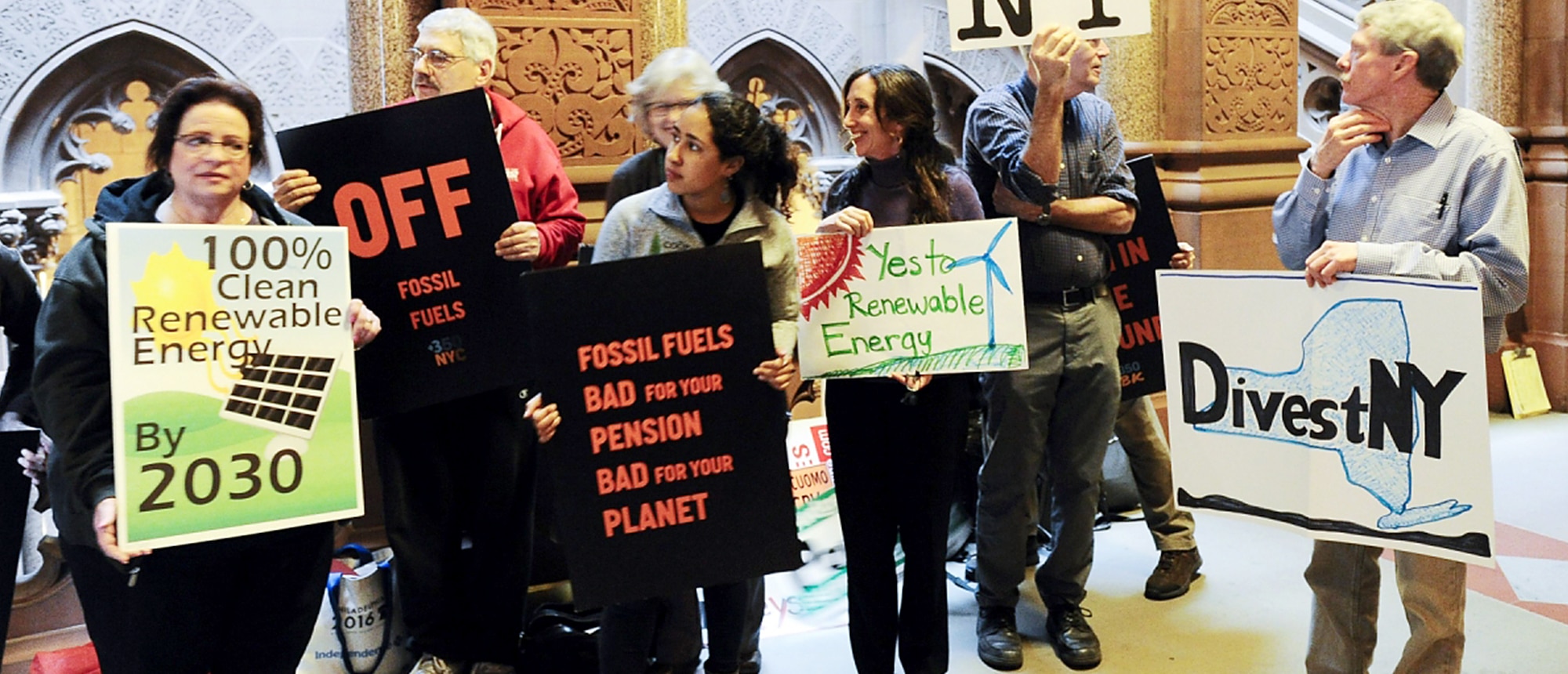Hit Fossil Fuels Where It Hurts – The Bottom Line
The divestment movement is having a big impact, and holdouts may be missing their one great chance to really change the world.
An envelope arrived from the New York State Comptroller’s office the other day, with a check inside for $108. Apparently I’d left it sitting in some bank account years ago, and now it was being returned. Free money is good fun, and where we live $108 buys you the best dinner in town, which my wife and I enjoyed, raising a small toast to the efficiency of the Empire State’s comptroller, Thomas DiNapoli.
But only a small toast. Because as smoothly as DiNapoli seems to perform the basic duties of his office, he has so far whiffed on the one great chance he’ll ever have to really affect the world. He’s continuing to invest billions of pension dollars in big oil, even as the industry refuses to grapple seriously with global warming. Because of his high-profile insistence on “engagement” with the industry, he’s become a stand-in for a thousand other political “leaders” who can’t quite summon the nerve necessary to break with the fossil-fuel industry, even when science and economics are making it clear where the future must lie. It’s so much easier to keep doing what you’ve always done – but at this point inertia is the planet’s most powerful enemy, and DiNapoli is threatening to become inertia’s avatar.
The movement for fossil-fuel divestment was partly born in the pages of this magazine six years ago, when an essay of mine went unexpectedly viral. That piece showed the new math of climate change: The big oil, gas and coal producers had reserves in the ground that contained five times the carbon any scientist said we could burn and stay below the catastrophic temperature rises that the planet’s governments had pledged to avoid. That is, the business plans of Exxon and Chevron and Shell and the rest committed them to wrecking the planet – simple math, simple physics and simple morality. If it’s wrong to wreck the planet, it’s wrong to profit from the wreckage.
That argument was enough to get the ball rolling. Students at hundreds of campuses around the world launched divestment campaigns that echoed the one against South African apartheid a generation ago. The first school to divest was tiny Unity College in Maine, which pulled its $13 million endowment in November 2012. By this winter, the University of California system, biggest in the hemisphere, had joined, along with a third of the universities in the U.K., and the World Council of Churches, and dozens of Christian denominations and Catholic diocese, as well as many of the biggest foundations on the planet. Even the Rockefeller heirs, who trace their fortune to the original oil baron, have sold their shares. By now endowments and portfolios worth more than $6 trillion have divested in part or in whole, and it’s become by far the biggest effort of its kind in history.
And intriguingly, most of the recent converts have been moved as much by self-interest as by moral fervor. As the years have gone by, the fossil-fuel sector has dramatically underperformed the rest of the economy. That’s because it’s under increasing and unrelenting pressure from new technology – the ever-cheaper solar and wind power that everyone can see will take a huge chunk of their business away. So now it’s also the largest insurance company in France that’s divested, and the sovereign wealth fund of Norway (the biggest pool of money on Earth, earned from North Sea oil wells). When New York City decided to divest in January, the press conference was held in a building flooded by Hurricane Sandy – clearly fear of climate change was the key reason for divestment, and they lit up the Empire State Building green that night to make the point. But the green, as Mayor Bill de Blasio was quick to point out, also stood for the money the city was saving its pensioners by ensuring that they weren’t stuck paying for the fossil-fuel decline.
There have been holdouts, of course – Harvard, run by a “board of overseers” drawn heavily from Wall Street, refused to participate officially. And then there’s DiNapoli, who’s played the most intriguing role. So far he’s failed to divest the state’s $200 billion in pension funds from fossil fuels despite a demand from New York’s Gov. Andrew Cuomo that he do so, and despite the example set by the state’s biggest city, whose own comptroller, Scott Stringer, has become an outspoken advocate for divestment. Though DiNapoli clearly has the political backing to divest the state’s holdings, he’s continued down a different path, promising to “engage” with the fossil-fuel companies instead, to somehow turn them green. In the meantime, it’s business as usual. In fact, the state continues to run up its investment in Exxon, filthiest of them all – it’s now the fifth-biggest investment in New York state’s portfolio.
Shareholder engagement with companies can be a powerful tool: Big investors routinely use their clout to argue for, say, more diverse representation on company boards of directors, or for modest changes in the way they do their business. But it’s an approach that’s never made much sense with the fossil-fuel industry, where the problem is not some flaw in the business plan. The flaw is the business plan. Exxon exists to dig up hydrocarbons and sell them so they can be burned. DiNapoli apparently thought he could force real change: For years he and others sponsored resolutions at Exxon annual meetings demanding reforms. Finally, a year ago, the company grudgingly agreed to prepare a “climate risk report” showing how the fight against global warming might stress their business model. It wasn’t much of a victory, but it seemed like something to show for all that work. DiNapoli, being a politician, issued a press release praising himself. “Exxon’s decision demonstrates that investors have the power to hold corporations accountable and to compel them to address our very real climate-related concerns,” he said.
But he and his like-minded colleagues were being played for fools. Exxon took just a few weeks to prepare the report, and when it came out it showed the company hadn’t changed one whit. Climate change posed essentially no risk to its future, Exxon insisted. It still planned on burning almost all its reserves, and indeed would go on exploring for new oil. It was Lucy with the football, and DiNapoli was Charlie Brown lying on his back. To add insult to injury, the industry arranged for the Trump administration to lift a block on offshore oil drilling along the Atlantic coast – including Long Island, where DiNapoli began his political career. As an environmentalist.

